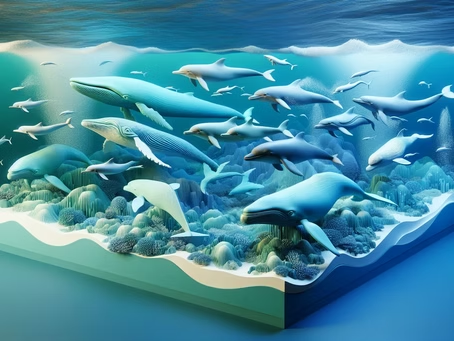The Struggle of Whales and Dolphins
Whales and dolphins, the ocean’s most iconic creatures, face mounting threats from human activity and environmental change. Their survival depends on a combination of international cooperation, local initiatives, scientific innovation, and the collective efforts of individuals worldwide. Protecting them means safeguarding the health of entire marine ecosystems.
Current State of Cetacean Populations
Population Declines
- Blue whales remain vulnerable after historic whaling and ongoing risks.
- The vaquita porpoise is nearly extinct with only a handful remaining.
- Orcas face food shortages and toxic pollutants in their habitats.
These numbers reveal a stark truth: without urgent action, many cetaceans may vanish within decades.
Geographic Hotspots
- Coral Triangle: threatened by destructive fishing practices
- Great Barrier Reef: climate change impacts
- Gulf of California: entanglement in fishing gear
- Bay of Biscay: heavy shipping traffic
These critical regions highlight the urgent need for conservation on both local and global scales.
Major Threats to Cetaceans
Hunting and Habitat Loss
Though commercial whaling has declined, illegal hunting persists in some regions. Meanwhile, coastal development, ship collisions, and climate change continue to erode vital breeding and feeding grounds.
Bycatch and Fishing Nets
Dolphins often fall victim to fishing nets, leading to injury or death. Gear modifications and restricted fishing zones are being implemented to reduce accidental captures, though challenges remain.
Pollution and Noise
- Chemical pollution weakens dolphin immune and reproductive systems.
- Noise from ships and sonar disrupts communication and navigation.
These threats ripple across marine ecosystems, destabilizing food webs and biodiversity.
Conservation in Action
International Agreements
- IWC: moratorium on commercial whaling
- CITES: controls on endangered species trade
- MMPA: U.S. law influencing global standards
While crucial, these laws require stronger enforcement to be fully effective.
Community-Led Initiatives
- Sustainable fishing practices
- Beach clean-ups
- Education and awareness programs
Grassroots action empowers local voices and delivers immediate, tangible impact.
Technology and Innovation
- Drones for non-invasive monitoring
- AI to detect distress calls and migration shifts
- Satellite tagging for real-time tracking
These tools provide valuable insights to support evidence-based conservation strategies.
The Role of Sanctuaries
Safe Havens
From Hawaii’s humpback sanctuary to India’s dolphin reserves, protected areas are proving effective at reducing threats and providing secure habitats.
Challenges
- Securing sustainable funding
- Enforcing protections in international waters
- Balancing local needs with global conservation goals
How Individuals Can Help
- Raise awareness through education and advocacy
- Support sustainable seafood choices
- Participate in beach clean-ups and citizen science projects
- Engage with policymakers to strengthen protections
Small individual actions, when multiplied, can generate global change for cetaceans.
Science Leading the Way
- Decoding whale and dolphin communication through acoustic research
- Studying genetics to preserve diversity and resilience
- Monitoring migration and ecosystem health through long-term observation
Scientific research continues to unlock critical knowledge for cetacean survival.
Looking Ahead
Climate change, ocean acidification, and rising sea temperatures will challenge whales and dolphins further. Innovations in AI, robotics, and acoustic sensors are providing new hope, but global unity is vital. By embracing science, technology, and cooperation, we can ensure these oceanic companions endure for generations to come.
Conclusion
The future of whales and dolphins depends on collective human will. Protecting them is not only about saving a species but preserving ocean health and planetary balance. Every voice, choice, and action counts in the fight to safeguard these remarkable creatures.

